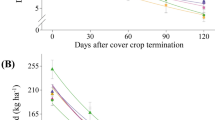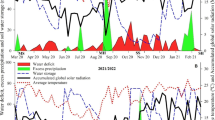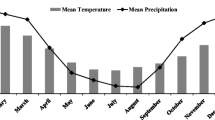Abstract
Background and aims
Understanding the fate of nitrogen (N) in maize (Zea mays L.) intercropped with tropical grass is essential to develop sustainable fertilization recommendations and mitigate greenhouse gas emissions. To test the hypothesis that intercropping forage grass with maize improves yield and fertilizer N recovery in the system, this study evaluated the recovery of N applied to maize intercropped with forage grass grown as a double crop after soybean [Glycine max (L.) Merrill].
Methods
A two–year field experiment was conducted. In each season maize was intercropped with either Guinea grass (Megathyrsus maximus; syn. Panicum maximum) or ruzigrass (Urochloa ruziziensis; syn. Brachiaria ruziziensis) in southeastern Brazil in the presence or absence of N fertilization, followed by a soybean crop. 15N–enriched ammonium sulfate was used to trace the fate of the applied N.
Results
Total recovery of fertilizer N by maize differed with season (≈ 35 and 22%) and was greater in the grain than vegetative fractions. Uptake of fertilizer N by intercropped forage grass was less than maize but substantial (≈ 11–18%) After maize harvest more than 60% of the N applied remained in the system, partly in forage grass and maize residues but mostly in soil. Up to 12% of the N applied was recovered by soybean grown in succession.
Conclusion
The introduction of either Guinea grass or ruzigrass intercropped with maize can decrease N losses from fertilizer and increase recovery by soybean grown after maize, particularly when maize yield and N uptake are low.






Similar content being viewed by others
Data availability
The datasets generated during the current study are available from the corresponding author on reasonable request.
References
Almeida REMD, Favarin JL, Otto R, Franco H, Reis AFB, Moreira LA, Trivelin PCO (2018) Nitrogen recovery efficiency for corn intercropped with palisade grass. Bragantia 77:557–566. https://doi.org/10.1590/1678-4499.2017242
Alvim MJ, Botrel MA, Xavier DF (2002) As principais espécies de Brachiaria utilizadas no país. Comunicado Técnico 22. EMBRAPA, Juiz de Fora
Barcelos JPQ, Souza M, Nascimento CAC, Rosolem CA (2022) Soil acidity amelioration improves N and C cycles in the short term in a system with soybean followed by maize–Guinea grass intercropping. Geoderma 421:115909. https://doi.org/10.1016/j.geoderma.2022.115909
Blake GR, Hartge KH (1986) Bulk density. In: Klute A (ed) Methods of soil analysis: part 1 physical and mineralogical methods, 5.1, 2nd edn. American Society of Agronomy, Madison. https://doi.org/10.2136/sssabookser5.1.2ed.c13
Boaretto AE, Spolidorio ES, Freitas JGD, Trivelin PCO, Muraoka T, Cantarella H (2004) Destino de 15N–uréia aplicada em sucessão trigo–soja. Bragantia 63:265–274. https://doi.org/10.1590/S0006-87052004000200011
Calonego JC, Rosolem CA (2008) Estabilidade de agregados do solo após manejo com rotações de culturas e escarificação. Rev Bras Cienc Solo 32:1399–1407. https://doi.org/10.1590/S0100-06832008000400004
Chen P, Du Q, Liu X, Zhou LI, Hussain S, Lei L, Song C, Wang X, Liu W, Yang F, Shu K, Du J, Yang W, Yong T (2017) Effects of reduced nitrogen inputs on crop yield and nitrogen use efficiency in a long–term maize–soybean relay strip intercropping system. PLoS One 12:e0184503. https://doi.org/10.1371/journal.pone.0184503
Coplen T (2011) Guidelines and recommended terms for expression of stable–isotope–ratio and gas–ratio measurement results. Rapid Commun Mass Spectrom 25:2538–2560. https://doi.org/10.1002/rcm.5129
Costa NR, Crusciol CA, Trivelin PC, Pariz CM, Costa C, Castilhos AM, Souza DM, Bossolani JW, Andreotti M, Meirelles RL, Moretti LG, Mariano E (2021) Recovery of 15N fertilizer in intercropped maize, grass and legume and residual effect in black oat under tropical conditions. Agric Ecosyst Environ 310:107226. https://doi.org/10.1016/j.agee.2020.107226
Crusciol CAC, Nascente AS, Borghi E, Soratto RP, Martins PO (2015) Improving soil fertility and crop yield in a tropical region with palisadegrass cover crops. Agron J 107:2271–2280. https://doi.org/10.2134/agronj14.0603
Dietz S, Herz K, Gorzolka K, Jandt U, Bruelheide H, Scheel D (2020) Root exudate composition of grass and forb species in natural grasslands. Sci Rep 10:10691. https://doi.org/10.1038/s41598-019-54309-5
Dourado–Neto D, Powlson D, Abu Bakar R, Bacchi OOS, Basanta MV, Cong P, Keerthisinghe G, Ismaili M, Rahman SM, Reichardt K, Safwat MSA, Sangakkara R, Timm LC, Wang Y, Zagal E, van Kessel C (2010) Multiseason recoveries of organic and inorganic nitrogen–15 in tropical cropping systems. Soil Sci Soc Am J 74:139–152. https://doi.org/10.2136/sssaj2009.0192
Echer FR, Castro GSA, Bogiani JC, Rosolem CA (2012) Crescimento inicial e absorção de nutrientes pelo algodoeiro cultivado sobre a palhada de Brachiaria ruzigrass. Planta Daninha 30:783–790. https://doi.org/10.1590/S0100-83582012000400012
Galdos MV, Brown E, Rosolem CA, Pires LF, Hallett PD, Mooney SJ (2020) Brachiaria species influence nitrate transport in soil by modifying soil structure with their root system. Sci Rep 10:1–11. https://doi.org/10.1038/s41598-020-61986-0
Galloway JN, Aber JD, Erisman JW, Seitzinger SP, Howarth RW, Cowling EB, Cosby BJ (2003) The nitrogen cascade. Bioscience 53:341–356. https://doi.org/10.1641/0006-3568(2003)053[0341:TNC]2.0.CO;2
Gardner JB, Drinkwater LE (2009) The fate of nitrogen in grain cropping systems: a meta-analysis of 15 N field experiments. Ecol Appl 19:2167–2184. https://doi.org/10.1890/08-1122.1
Ghiberto PJ, Libardi PL, Trivelin PCO (2015) Nutrient leaching in an Ultisol cultivated with sugarcane. Agric Water Manag 148:141–149. https://doi.org/10.1016/j.agwat.2014.09.027
Grassmann CS, Mariano E, Rocha KF, Gilli BR, Rosolem CA (2020) Effect of tropical grass and nitrogen fertilization on nitrous oxide, methane, and ammonia emissions of maize–based rotation systems. Atmos Environ 234:117571. https://doi.org/10.1016/j.atmosenv.2020.117571
Herridge DF, Peoples MB, Boddey RM (2008) Global inputs of biological nitrogen fixation in agricultural systems. Plant Soil 311:1–18. https://doi.org/10.1007/s11104-008-9668-3
Hickman JE, Palm CA, Mutuo P, Melillo JM, Tang J (2014) Nitrous oxide (N2O) emissions in response to increasing fertilizer addition in maize (Zea mays L.) agriculture in western Kenya. Nutr Cycl Agroecosyst 100:177–187. https://doi.org/10.1007/s10705-014-9636-7
Hungria M, Franchini JC, Campo RJ, Crispino CC, Moraes JZ, Sibaldelli RN, Mendes IC, Arihara J (2006) Nitrogen nutrition of soybean in Brazil: contributions of biological N2 fixation and N fertilizer to grain yield. Can J Plant Sci 86:927–939. https://doi.org/10.4141/P05-098
Liu XE, Li XG, Guo RY, Kuzyakov Y, Li FM (2015) The effect of plastic mulch on the fate of urea–N in rain–fed maize production in a semiarid environment as assessed by 15 N–labeling. Eur J Agron 70:71–77. https://doi.org/10.1016/j.eja.2015.07.006
Luce MS, Grant CA, Zebarth BJ, Ziadi N, O’Donovan JT, Blackshaw RE, Harekr KN, Johnson E, Gan Y, Lafond GP, May WE, Khakbazan M, Smith EG (2015) Legumes can reduce economic optimum nitrogen rates and increase yields in a wheat–canola cropping sequence in western Canada. Field Crops Res 179:12–25. https://doi.org/10.1016/j.fcr.2015.04.003
Mazzafera P, Favarin JL, Andrade SAL (2021) Editorial: intercropping systems in sustainable agriculture. Front Sustain Food Syst 5:634361. https://doi.org/10.3389/fsufs.2021.634361
Miranda KM, Espey MG, Wink DA (2001) A rapid, simple spectrophotometric method for simultaneous detection of nitrate and nitrite. Nitric Oxide 5:62–71. https://doi.org/10.1006/niox.2000.0319
Momesso L, Crusciol CA, Soratto RP, Vyn TJ, Tanaka KS, Costa CH, Ferrari Neto J, Cantarella H (2019) Impacts of nitrogen management on no-till maize production following forage cover crops. Agron J 111:639–649. https://doi.org/10.2134/agronj2018.03.0201
Mulvaney RL (1996) Nitrogen—inorganic forms In: Sparks DL, Page, AL, Helmke PA, Loeppert RH (eds) Methods of soil analysis: Part 3 Chemical methods, 5. American Society of Agronomy, Madison. https://doi.org/10.2136/sssabookser5.3.c38
Nascente AS, Crusciol CA, Stone LF (2014) Straw degradation and N release from cover crops under not–tillage. Rev Caatinga 27:166–175
Oliveira PPA, Trivelin PCO, Oliveira WSD (2007) Urea 15 N balance in the fractions of a Brachiaria brizantha cv. Marandu pasture under recovery with different liming dates. Rev Bras Zootecnia 36:1982–1989. https://doi.org/10.1590/S1516-35982007000900006
Otto R, Castro SAQ, Mariano E, Castro SGQ, Franco HCJ, Trivelin PCO (2016) Nitrogen use efficiency for sugarcane–biofuel production: what is next? Bioenergy Res 9:1272–1289. https://doi.org/10.1007/s12155-016-9763-x
Paul D, Skrzypek G, Fórizs I (2007) Normalization of measured stable isotopic compositions to isotope reference scales – a review. Rapid Commun Mass Spectrom 21:3006–3014. https://doi.org/10.1002/rcm.3185
Redin M, Guénon R, Recous S, Schmatz R, Freitas LL, Aita C, Giacomini SJ (2014) Carbon mineralization in soil of roots from twenty crop species, as affected by their chemical composition and botanical family. Plant Soil 378:205–2014. https://doi.org/10.1007/s11104-013-2021-5
Rezende CDP, Cantarutti RB, Braga JM, Gomide JA, Pereira JM, Ferreira E, Tarré R, Macedo R, Alves BJR, Urquiaga S, Cadish G, Giller KE, Boddey RM (1999) Litter deposition and disappearance in Brachiaria pastures in the Atlantic Forest region of the South of Bahia, Brazil. Nutr Cycl Agroecosystems 54:99–112. https://doi.org/10.1023/A:1009797419216
Rimski–Korsakov H, Rubio G, Lavado RS (2012) Fate of the nitrogen from fertilizers in field–grown maize. Nutr Cycl Agroecosystems 93:253–263. https://doi.org/10.1007/s10705-012-9513-1
Rocha KF, Mariano E, Grassmann CS, Trivelin PCO, Rosolem CA (2019) Fate of 15N fertilizer applied to maize in rotation with tropical forage grasses. Field Crops Res 238:35–44. https://doi.org/10.1016/j.fcr.2019.04.018
Rosolem CA, Oliveira Neto L, Costa VE, Grassmann CS (2019) Ruzigrass root persistence and soybean root growth. Plant Soil 442:333–341. https://doi.org/10.1007/s11104-019-04198-4
Rosolem CA, Ritz K, Cantarella H, Galdos MV, Hawkesford MJ, Whalley RW, Mooney SJ (2017) Enhanced plant rooting and crop system management for improved N use efficiency. Adv Agron 146:205–239. https://doi.org/10.1016/bs.agron.2017.07.002
Rosolem CA, Steiner F, Zoca SM, Ducatti C (2012) Nitrogen immobilization by congo grass roots impairs cotton initial growth. J Agric Sci 4:126–136. https://doi.org/10.5539/jas.v4n9p126
Rosolem CA, Werle R, Garcia RA (2010) Nitrogen washing from C3 and C4 cover grasses residues by rain. Rev Bras Cienc Solo: 341899–341905. https://doi.org/10.1590/S0100-06832010000600014
Sainju UM, Singh BP, Whitehead WF (2000) Cover crops and nitrogen fertilization effects on soil carbon and nitrogen and tomato yield. Can J Soil Sci 80:523–532. https://doi.org/10.4141/S99-107
Smith CJ, Chalk PM (2018) The residual value of fertiliser N in crop sequences: an appraisal of 60 years of research using 15N tracer. Field Crops Res 217:66–74. https://doi.org/10.1016/j.fcr.2017.12.006
Soil Survey Staff (2022) Keys to soil taxonomy, 13th edn. USDA, Natural Resources Conservation Service, Washington, DC
Subbarao GV, Ishikawa T, Ito O, Nakahara K, Wang HY, Berry WL (2006) A bioluminescence assay to detect nitrification inhibitors released from plant roots: a case study with Brachiaria humidicola. Plant Soil 288:101–112. https://doi.org/10.1007/s11104-006-9094-3
Subbarao GV, Sahrawat KL, Nakahara K, Ishikawa T, Kishii M, Rao IM, Hash CT, George TS, Rao PS, Nardi P, Bonnett D, Barry W, Suenaga K, Lata JC (2012) Biological nitrification inhibition–a novel strategy to regulate nitrification in agricultural systems. Adv Agron 114:249–302. https://doi.org/10.1016/B978-0-12-394275-3.00001-8
Tilman D, Balzer C, Hill J, Befort BL (2011) Global food demand and the sustainable intensification of agriculture. Proc Natl Acad Sci 108:20260–20264. https://doi.org/10.1073/pnas.1116437108
Urquiaga S, Cadish G, Alves BJR, Boddey RM, Giller KE (1998) Influence of decomposition of roots of tropical forage species on the availability of soil nitrogen. Soil Biol Biochem 14:2099–2106. https://doi.org/10.1016/S0038-0717(98)00086-8
Vahdat E, Nourbakhsh F, Basiri M (2011) Lignin content of range plant residues controls N mineralization in soil. Eur J Soil Bio 47:243–246. https://doi.org/10.1016/j.ejsobi.2011.05.001
van Raij B, Andrade JC, Cantarella H, Quaggio JA (2001) Análise química para avaliação da fertilidade de Solos Tropicais. Instituto Agronômico de Campinas, Campinas
Wang S, Luo S, Yue S, Shen Y, Li S (2016) Fate of 15 N fertilizer under different nitrogen split applications to plastic mulched maize in semiarid farmland. Nutr Cycl Agroecosystems 105:129–140. https://doi.org/10.1007/s10705-016-9780-3
Acknowledgements
This work was supported by the São Paulo Research Foundation (FAPESP), grants 2019/15563–7 and 2018/15867–3.
Funding
This work was supported by the São Paulo Research Foundation (FAPESP), grants 2019/15563–7 and 2018/15867–3.
Author information
Authors and Affiliations
Contributions
C.A. Rosolem, E. Mariano, and B. Gazola contributed to the study conception and design. B. Gazola, E. Mariano, and M.G.O. Andrade conducted the experiment both in the field and laboratory and wrote the first draft. V.E. Costa was responsible for 15N analysis. E. Mariano, C.A. Rosolem, and V.E. Costa wrote the revised versions. All authors read and approved the final manuscript.
Corresponding author
Ethics declarations
Competing interests
The authors have no relevant financial or non–financial interests to disclose.
Additional information
Responsible Editor: Euan K. James.
Publisher’s note
Springer Nature remains neutral with regard to jurisdictional claims in published maps and institutional affiliations.
Rights and permissions
Springer Nature or its licensor (e.g. a society or other partner) holds exclusive rights to this article under a publishing agreement with the author(s) or other rightsholder(s); author self-archiving of the accepted manuscript version of this article is solely governed by the terms of such publishing agreement and applicable law.
About this article
Cite this article
Gazola, B., Mariano, E., Andrade, M.G.O. et al. Fate of fertilizer N applied to maize intercropped with forage grass and recovery of residual N by soybean in a double cropping system. Plant Soil 496, 205–219 (2024). https://doi.org/10.1007/s11104-023-06139-8
Received:
Accepted:
Published:
Issue Date:
DOI: https://doi.org/10.1007/s11104-023-06139-8




